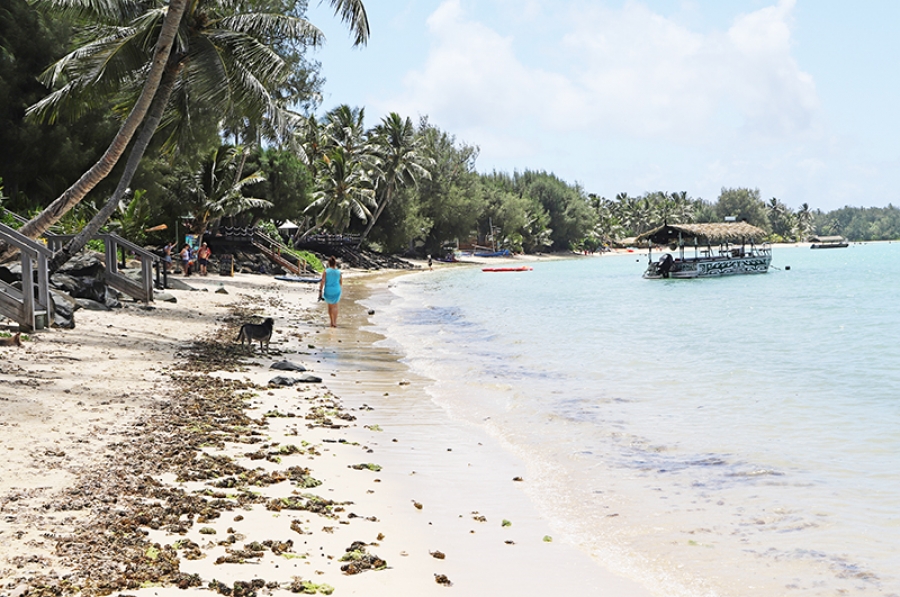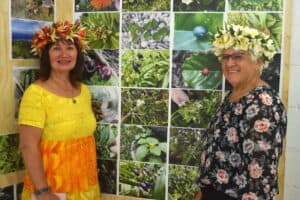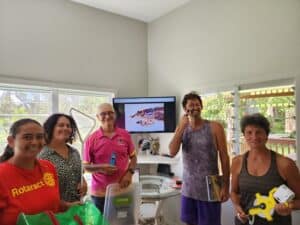The Muri lagoon was officially declared a national disaster back in 2015 and is currently contaminated from agricultural pollution, including sediments and nutrients that impact the water quality, ecosystem diversity, and its appearance.
The government says that these research projects could help curb some of the pollution blamed for pushing the lagoon to what some scientists have described as “unsustainable”.
Since 2015, a major algae overgrowth has appeared forming in the lagoon and is washing up on Muri shores, scenes that experts have repeatedly blamed on agricultural pollution.
Scientists say the algae has been caused by tonnes of nitrates and excess nutrients from wastewater leaking into the lagoon, triggering a phenomenon called lagoon cyanobacteria – which can cause a thick scum on the surface of the water and nasty odours.
The excess nutrients and agricultural run-offs also trigger eutrophication which collapses aquatic ecosystems.
Back in December 2020, scientists with the Ministry of Marine Resources (MMR) said they believed the lagoon – already dealing with excessive algae – experienced an anoxic event, which occurs when a body of water is depleted of significant amounts of dissolved oxygen, affecting marine life.
Since then the lagoon has been observed to be heavily saturated with decomposing algae and a foul smell. The decline in dissolved oxygen also resulted in the discovery of dead fish and other sea life along the shore.

According to the Natural Environment Service (NES), these research projects which will be short and medium-term steps to slash the contaminants entering the lagoon will help revitalise the Muri shoreline.
Both the NES and the Ministry of Marine Resources (MMR) say they are investigating bioremediation options which include both terrestrial and marine interventions, as well as possible environmental engineering solutions.
Bioremediation is the use of microorganisms that help clean up or remediate contaminated soil and groundwater.
In a coordinated response with MMR, NES director Halatoa Fua says: “This work will help to address sedimentation in the lagoon and mitigate some of the nutrient issues over time.”
“Monitoring impacts particularly on nutrient loads in the lagoon and impacts on the marine ecosystem, such as coral coverage and health, will be strengthened.
“With borders now open with NZ, access to additional expertise will assist in progressing this work.
“Further work with the community groups such as the Trevally Group (TG) and the Muri Environment Care Group (MECG) will be revisited to ensure a coherent approach is undertaken.”
For terrestrial interventions, Fua says both government departments are looking at using plants like Vetiver grass for stream banks, and areas requiring soil stabilisation.
Over the last six months, he says the NES and MMR have teamed up with the MECG to plant Vetiver grass along waterways, replacing invasive species and areas that are prone to flooding and erosion.
“Working with the MECG and the Natural Heritage Trust, the MMR and NES are looking initially at species found locally that can be propagated to support planting efforts,” says Fua.
“Additionally, marine invertebrates such as Rori and Paua that have natural filters and cleaning functions for both marine sediments and water quality are being propagated to restock the Muri lagoon.
“This will be supported with MMR upgrades to its hatchery in Aitutaki.”
Different seaweeds and grasses have also been looked at, to possibly replace the algae species in Muri to help remove nutrients from the water, but also have the added benefit of carbon sequestration, adds Fua.
“Some type of marine plant will have to remain to maintain the function of nutrient removal until longer infrastructure solutions and land use and practices are implemented.”
Citing years of inaction by the government, last year a group of residents in Ngatangiia called on elected leaders and officials to make rehabilitation of the lagoon – often described as “the crown jewel of Rarotonga” – a national priority.
A set of strict demands were made to immediately address the perilous state of Muri lagoon littered by algae overgrowth.
Among the demands made, the group called for the National Environment Service to protect the area from future development by halting the issuing of development permits for “any wetlands or immediate foreshore areas”.
The group also demanded that the Environment Service enforce a total ban on the spraying of chemicals along the banks of all waterways and wetlands in Muri and Avana.
During question time in Parliament late last year, the Member of Parliament for Ngatangiia Tamaiva Tuavera also brought up the issue of the poor state of Muri lagoon.
Tuavera asked: “What are we going to do about this once pristine lagoon in Muri?”
In response, Prime Minister Mark Brown said the lagoon was going to take many years before it resolved itself.
Brown said suggestions of increasing water flow into the lagoon, like opening channels and dredging Avana harbour could have unintended consequences on the lagoon health.
He said the plan is to improve the sanitation and sewage flow in Muri.
Brown said: “It calls for a modern collective treatment facility, which makes sure no wastewater goes directly into the ground and leaches into the lagoon.”
According to the Environment Service and the MMR, a proper waste-water management system is the key bit of work required to improve the health of the lagoon.
Fua says work undertaken through the Mei Te Vai Ki Te Vai (MTVKTV) project, and the solutions they have created for a waste-water management system, directly responds to the primary cause of the algae growth in Muri lagoon and the decline in its overall health.
He says a proper waste-water management system is appropriate since the Cook Islands are dealing with nonpoint nutrient sources, which can include excess fertilizers, sediment from eroding stream banks, and urban run-offs such as oil and toxic chemicals.
However, both departments say the effectiveness of these systems once in place can take between 10 to 15 years for nutrients existing in the environment to work their way through to the lagoon.
They say short and medium-term solutions that supplement this are needed.
Muri Environment Care volunteer Anne Tierney welcomed the news about the research projects which are underway for the Muri lagoon.
“It’s very, very welcomed news,” says Tierney.
“I think the community will really appreciate it and want to be part of it. Because this community are really passionate about Muri lagoon.
“A lot of families have lived here for generations and have a deep attachment and feel responsible for the wellbeing of the lagoon. So all these other things are part of the challenge of trying to get it in better shape.
“Over the years it has been quite heart-breaking to watch the lagoon become the way it is… heavily decomposed with algae and that smell.
“But I feel a lot more optimistic that things can be done, especially with the right people here who have the skills to be able to deal with these things.”



